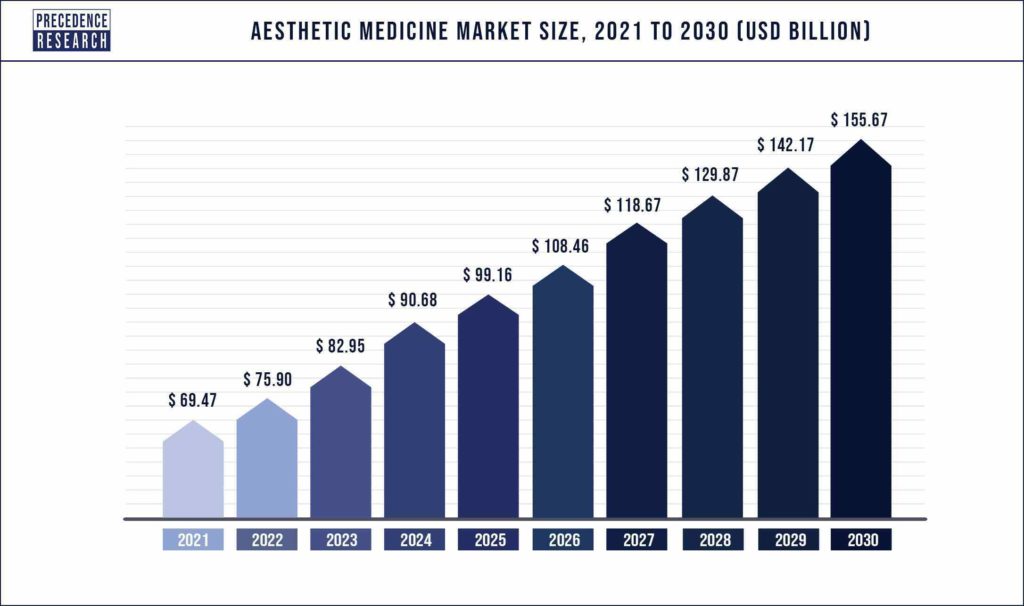According to IMACS, two factors are driving the growth dynamic. First, there is an expected growth of 8 to 9% per year in the body contouring and injection markets. Second, there is a strong demand in the Asia-Pacific and Latin America regions, with an average annual growth rate close to 9%, which is higher than in North America and Europe (between 7 and 8%). However, the US remains the leading market, with 45% of worldwide sales, ahead of Asia-Pacific (23%), the European Union (21%) and Latin America (11%). In the surgical field, the two leading procedures remain liposuction and breast augmentation by prosthesis, both in Europe and worldwide.
Most sectors are expected to achieve an annual average growth ranging from 7 to 9%. This is the case for injectable products, which represent half of the market. This large group is divided between filling products (€3.15 billion in 2019), mainly hyaluronic acid, and the botulinum toxin sector (€2.47 billion). Behind them are cosmeceuticals (1.57 billion), which are medical cosmetics products, ahead of energy-based equipment (1.52 billion) – including lasers, radio frequency, ultrasound and body contouring devices – and the smallest sector, morphological implants (0.94 billion).
Finally, the breast implant sector (1.28 billion) will experience limited growth at an average annual rate of 3.3%, according to IMCAS, due to steady demand and stricter regulations following the PIP scandal and safety problems with some implants withdrawn from the European market in early 2019.
“Lipofilling” or fat reinjection is developing.
What is lipofilling?
Lipofilling is a transfer of fat and fat stem cells from one part of the body to another. The procedure begins with a liposuction.
Liposuction has always been a very popular cosmetic surgery procedure. Belly, buttocks, thighs, knees, but also chin or arms… the goal is to remove unwanted fatty deposits in these areas by suctioning the fat. Liposuction has been around for decades, and the techniques have constantly improved over the years.
Lipofilling involves sucking up the fat with a cannula, then centrifuging it, purifying it and reinjecting it into areas that lack volume.
How much does cosmetic surgery cost in Los Angeles?
The cost of cosmetic surgery in Los Angeles depends on many factors. The price varies according to the type of surgery and the surgeon who performs it.
Here are the average prices for common cosmetic surgery procedures:
Surgery Price
Breast augmentation Between $7,000 and $10,000
Liposuction Between $6,550 and $14,000a
Rhinoplasty Between $9,000 and $20,000
Blepharoplasty Between $5,000 and $15,000
Facial lift Between $16,000 and $25,000
Botox injection Between $425 and $2,500
Abdominoplasty Between $8,725 and $14,000
Breast Breas Between $9,000 and $11,500
Laser liposuction Between $4,700 and $6,000
Neck lift Between $9,400 and $15,000
Fat transfer Between $5,000 and $8,000
GynecomastiaGynecomas Between $5,600 and $7,500
Mentoplasty Between $6,000 and $10,000
Coolsculpting Between $2,000 and $9,000
Lip injections Between $700 and $3,000
Hair transplants Between $9,000 and $15,000
Breast reduction Between $8,000 and $14,000
Brachioplasty Between $6,000 and $8,800
Buttock lipo filling Between $9,000 and $12,000
More and more surgeons are coming together to maximize their market share. Investment funds are also trying to position themselves and are looking for new opportunities. Recently, a major East Coast aesthetic practice was acquired for several hundred million dollars. Hybrigenics, a small French company that sells an FDA-accredited device (adip’sculpt), would soon be bought by a group of American investors.
The rise of digital technology
The progress in digital technology, artificial intelligence, 3D imaging and augmented reality is giving a new momentum to the medical and surgical aesthetic market. These developments provide better access to customized tools, improved diagnosis and simulations. This leads to more effective teaching and training methods for patients and practitioners.
You may also like
-
THE UNIVERSITY OF OKLAHOMA WELCOMES 5th GREAT GRANDDAUGHTER OF SEQUOYAH LISA CHRISTIANSEN TO PARTICIPATE IN 110th ANNUAL SPRING POWWOW SATURDAY, APRIL 20 | LLOYD NOBLE CENTER
-
Books Over Bucks: Professor Aman’s Journey with First Book School
-
Capturing Stories, Connecting Worlds: The Journey of Cade Chudy and 4th Shore Productions
-
The Multidimensional Universe: A New Theory Unfolds
-
Lights, Camera, Impact: Antoine Gijbels’ Inspiring Videography Journey

